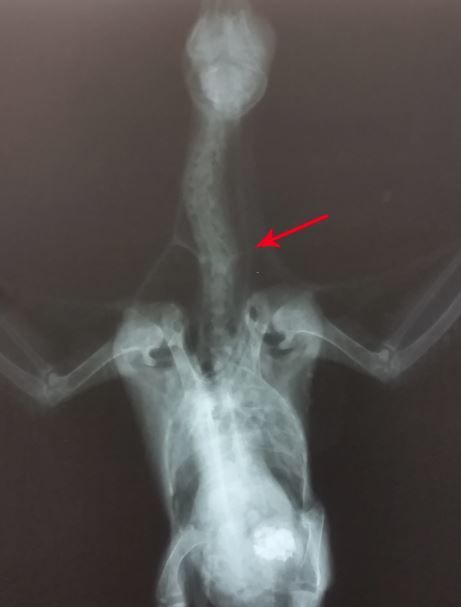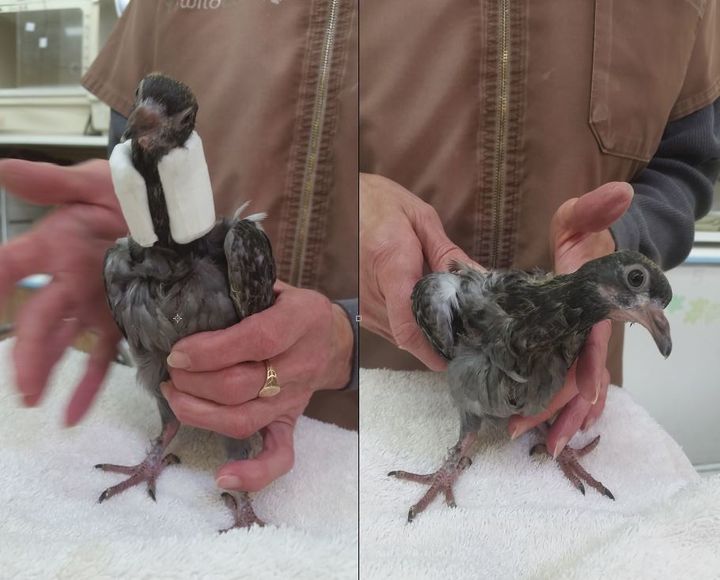When this pigeon’s rescuers saw her lying in a contorted position on the sidewalk in Oakland, California, they thought she was dead. But then she tried to move, and rescuers realized the bird was alive. When they picked her up, her neck was hanging to her feet with her head twisted upside down.
Knowing that WildCare is one of the few centers in the area that treats injured Rock Pigeons, they drove her across the bridge to San Rafael.

Intake Day 1.
Upon arrival at WildCare, the fledgling pigeon was rushed into intensive care to determine what was actually wrong with her and what could be done to help her. Pigeons can suffer from a virus called Paramixovirus (PMV) which causes neurological symptoms and loss of motor control. Unfortunately this virus can also mimic numerous afflictions such as poisoning and head trauma. WildCare Medical Staff needed to determine the cause of this pigeon’s severe neck twist in order to determine the best course of treatment.

Radiograph showing the broken vertebrae.
The pigeon was given pain medications and anti-inflammatories. Radiographs (x-rays) clearly revealed that this bird did in fact have a compression fracture of the neck so we could rule out PMV and poisoning. We will never know whether the pigeon injured herself in her first attempt at flight, landing improperly on sidewalk below, or if she was resting on the sidewalk and a passerby caused her harm.
A broken neck is a serious injury for any species but this pigeon had a lot going for her. She was young (growing baby animals can heal very quickly) and despite her injury, she still had use of all her limbs. And she was here with us at WildCare!
It was clear that this case was a long shot and would require intensive, around-the-clock care so Director of Animal Care Melanie Piazza accepted the challenge, applying techniques learned from past cases of nestling songbirds with similar neck injuries.
Piazza worked to design a neck brace that would keep the bird’s neck in alignment so it could heal properly, but that wouldn’t be so heavy that the bird couldn’t remain upright. The brace also had to allow enough space for the pigeon to be tube-fed four times a day, and to allow her crop (located at the base of the bird’s neck) to hold food without causing regurgitation.
Piazza tried many iterations of neck braces which changed as the pigeon’s strength, activity level and size changed. She tried adapting various items to create what was needed, including a padded toilet paper tube! Her most successful design was the most minimal. The base layer was the soft bandage material called cast padding, which was then covered by “vet wrap,” a flexible wrap that sticks only to itself, not to the patient in care. This brace provided the stability required.

Day 4 (trying a different splint design using a trimmed toilet paper roll). The bird can already somewhat hold her head up.
As light as Melanie made the brace, it was still too heavy for the bird to hold upright. Melanie devised a wrapping technique that brought a strap of the vet wrap from the neck brace over the bird’s back and under her wings, creating a sort of “figure-eight” suspender system that took the tension and weight of the brace off the bird’s neck. These “suspenders” allowed her to hold her head up and walk normally.
In addition to pain medications, the pigeon was also put on a course of calcium to assist her healing and growing bones. She was tube-fed four times a day as she could not eat with the contraption on. The brace was changed every two days and the bird’s weight, pain medications and general progress were closely monitored at WildCare during the day, and she stayed in home care with Piazza through the nights and weekends.
In the video below, taken four days after the brace was first applied, although she is obviously still wobbly and somewhat crooked, the pigeon is already starting to be able hold her head up on her own!
On day 5 another set of radiographs were taken to check her progress and Medical Staff was amazed to see the degree of healing that had taken place! Melanie started leaving the brace off overnight, to give the bird time to build her strength and also to do some much-needed grooming. As the days passed, she became increasingly able to hold her head up with less shaking for longer periods of time and the padding was removed from her carrier, allowing her more space to move around.
While her neck fracture was still healing we could not risk placing her in a cage with other rambunctious fledgling pigeons. We put a mirror in her carrier and her carrier was placed next to others, but this wasn’t enough interaction for such a socially developed species. By day 10 the bird was strong enough to be introduced to other pigeons her own age in a roomier cage!
In the video below, you can see the first meeting of our patient and her new friends. To everyone’s astonishment, she watched them self-feeding from a dish and almost immediately copied their behavior, eating out of the dish on her own with the neck brace on! This was something Melanie had been trying to get her to do but assumed she could not because of the brace. This is one of the reasons WildCare always raises orphaned baby animals with members of their own species– they learn so much from each other.
On day 14, just two weeks after her debilitating neck fracture, the brace has been removed and the pigeon is fully functioning! She is currently growing and learning with her new friends and soon the trio will graduate to an outdoor aviary to learn how to fly. Watch the video below to see our pigeon patient looking sleek and healthy. We’re so pleased with her amazing recovery and so happy she has a second chance at a life in the wild!
